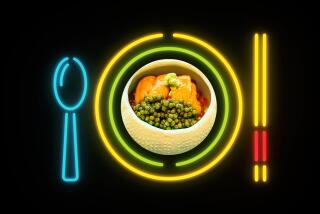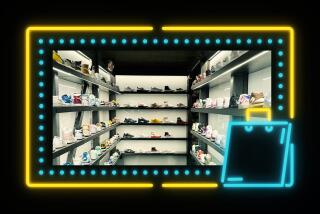Belly Up to the Hot New Designs
- Share via
Janice Fowles knows that the true art of gambling isn’t in knowing whether she should hit a soft 17, but how she can slip her employer’s brand name, like a good-night kiss, into a gambler’s feverish dreams.
Thirty million people flocked to Las Vegas last year to stroll at midnight under the blazing neon, salute a warm dawn with a cool drink--and harken to the siren call of the Double Wild Rose or the Triple Triple Diamond.
For all the allure of white tiger, showgirl and miniature Manhattan, Las Vegas is a city that thrives because many of those visitors arrived with visions of big jackpots.
But for the year, they left behind more than $3.6 billion in the town’s 125,000 slot machines.
In a typical casino, packed with hundreds of coin-gulping devices, customer loyalty is forged by name recognition, which Fowles has helped to achieve in her job as senior graphics designer at the world’s largest slot machine maker, International Game Technology Inc. of Reno.
These are exciting times for Fowles and her fellow design professionals, who have assembled a growing body of high-stakes commercial art on what is known inelegantly as “belly glass.”
Modern electronic slot machines, introduced in about 1980, had a 9-by-20-inch front panel at about waist level, showing the machine’s coin denomination. But starting in about the mid-1980s, that belly-level panel began to display the name of the game, thus launching a little-recognized design medium.
While not quite as racy as the pinball machine art that decorated taverns and bowling alleys earlier this century, belly glass art--with its vivid, glowing colors and arresting composition--entices players into seeking out their favorite slot machines in crowded casinos.
Fowles designed Triple Triple Diamond in 1995. It is a three-reel game for two or three coins, either quarters or dollar tokens.
Triple Triple is one of many offshoots of Double Diamond, one of IGT’s first games to achieve success because it evinced a theme rather than just bearing a denomination and a pay table.
Double Diamond debuted in 1990 and continues to be one of the most popular slot machines in the United States, says IGT spokesman Rick Sorensen.
“With the diamond games, we want to impart an elegance and a brilliance,” Fowles said. “I chose a standard round brilliant diamond and a black background so the colors would jump out.”
For lettering, Fowles used a font she designed in 1984 while working on her master’s degree at the University of Utah. “I had no idea that type face would someday be on slot machines,” she said.
Coming up with new ideas is a constant challenge for slot machine makers. One of the latest, from Las Vegas-based Sigma Game Inc., is 3 Way Doubles, with graphic design by company art director Darren DeWall.
Sigma marketing manager Marcus Prater says new games spring from the mathematical creativity of software engineers who devise payouts based on the arrangement of different symbols.
In 3 Way Doubles, a watermelon, bell or cherry marked “double jackpot” on the pay line doubles the payout, while two of them quadruples the return.
After the engineers design a game, Prater said, they brainstorm it with DeWall, who comes up with graphic images to breathe life into the cold numbers.
A good way to do that is to call on familiar images, such as the well-known series of rumpus room paintings by Cassius Marcellus Coolidge (1844-1937) of a canine poker party that inspired Top Dog, a machine being test-marketed by Casino Data Systems Inc. of Las Vegas.
CDS creative director Byron Harris led designers David Dace and Analisa Burden in playing off a well-worn theme for a new video reel slot machine--it has “virtual” reels that exist only on the computer screen.
While Top Dog is obviously aimed at male gamblers, Bally Gaming Inc. of Las Vegas has found success with Double Wild Rose, a three-reel, two-coin game that appeals to the opposite sex.
“We have found that the market is predominantly female,” said Larry Maier, Bally Gaming’s director of graphic design, “so we felt the look of this game would be more appealing to women.”
“We use Shelley script, which is a very feminine, ornate font,” said Maier. “It’s saying, ‘Go ahead and let your hair down.’ It’s a play on words a little bit. Wild symbols are popular symbols of our industry, and people who are familiar with wild and double symbols understand that.”
Another popular slot machine symbol is the red 7, which inspired Bally Gaming’s Triple Blazing 7s. Bob Manz, Bally Gaming’s special projects manager, designed the Blazing 7s about 10 years ago, Maier says.
“If a game’s got a red 7 with fire on it, it’s going to work,” he says. “It’s a simple idea: the old adage in gambling that this machine is hot, it’s ready to hit, that kind of thing.”
Amid all the successful machines, there have been memorable flops. Maier said he once designed a machine with daffy-looking fruit symbols called Plum Crazy. “We thought it was a cute game, but for the most part it didn’t do well anywhere except for a couple of locations in Canada.”
And even for outstanding slot machine art, recognition is not easy to come by. One of the few exhibitions in memory was assembled by the Nevada Museum of Art in Reno, which three years ago displayed 22 plates.
But even though slot machines may never die, all media eventually pass away. Perhaps the end of belly glass art is foreshadowed by Palo Alto-based Silicon Gaming Inc., which last year introduced the Odyssey slot machine, which has no belly glass. Instead, it has one big 26-inch video monitor.
The Odyssey’s astonishingly high-resolution graphics and sparklingly clear digital sound system draws gamblers curious to see it work, but so far not eager to drop a lot of money into it. Times are changing, but how far and how fast is the $64 question.
But in the end, this is not a field for the revolutionary. IGT’s Sorensen notes that slot machines now have buttons marked “spin reels” that players can push. With that, he says, “We thought we’d see the end of the slot handle. But people still like to pull it.”


